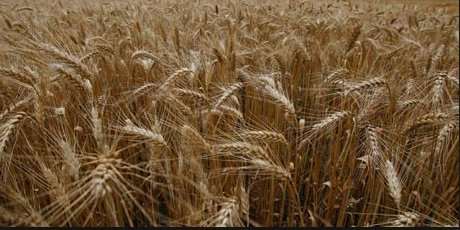
Kansas experienced the wheat “crop of a lifetime” this summer.
The wheat harvest in Kansas wrapped up last month with higher yields than expected,according to numbers from the U.S. Department of Agriculture. That’s good news for buyers, but rough on farmers, who now have to contend with low prices and lack of storage as they head into fall harvests for other crops.
Winter wheat, which initially was forecast in May to yield 43 bushels per acre, ended up producing an average of 56 bushels per acre, a full 7 bushels above the old record yield set in 1999. That total is much higher than last year’s harvest, which ended up producing only 37 bushels per acre.
Production was so much higher than normal that farmers and co-ops are scrambling to find storage.
“The tremendous excess that we’ve experienced faces the handling industry with quite a challenge,” said Tom Tunnell, CEO of the Kansas Grain and Feed Association.
Tunnell said that as elevators fill up, farmers might begin looking at nontraditional ways to store their crops, like using abandoned warehouses or just piling it on the ground.
That’s already happening in southern Kansas, where the Farmers Co-op in Wellington has begun putting wheat in bunkers and in piles on the ground, covered with tarps.
“We’ve never had to do that before,” said Curt Guinn, the co-op’s manager.
Because the price of wheat has gone down by more than a dollar a bushel since the harvest ended, many farmers are waiting to sell to the co-op, Guinn said, and choose to just store the grain at the co-op for a while, until prices rise. Wheat can stay in temporary storage for up to nine months and, Guinn said, prices should pick up during the winter.
But co-ops still have to make room for the upcoming fall harvests.
“It’s creating a storage debacle, not only from wheat, but we will have soybeans, corn and milo coming in,” said Pete Loewen-, owner of Loewen and Associates, a consulting and commodity brokerage firm in Manhattan.
Marsha Boswell, director of communications for trade group Kansas Wheat, said that mild temperatures helped create an exceptional yield. Now farmers will have to export their harvest before the fall crops come in. But Boswell said farmers aren’t very happy with the falling price of wheat.
“When income doesn’t match cost of production, it’s a bittersweet year,” said Boswell. “Farmers have a lot of wheat, but prices are terrible.”
Kenny Carlton grows wheat, milo and soybeans in Little River, in central Kansas. He contracted to sell most of his wheat before the harvest and didn’t have to worry about storing it. But he’s concerned that there won’t be room for his milo and soybeans at the Mid-Kansas Co-op this fall.
“It’s going to take some natural disaster in Russia or China to work through the stock of wheat we have worldwide,” he said. “And it will be just the same with corn.”
Last year, Kansas winter wheat averaged $4.85 per bushel, according to the USDA’s state agriculture overview. In its July 2016 report, the USDA noted that world production was increasing overall as well, boosting international trade but lowering prices.
Ukraine and Russia also had good harvests this year, lowering demand for Kansas exports and shuttering harvests in storehouses. A high fall U.S. yield of soybeans, corn and milo, which is expected, could exacerbate problems.
The story is the same everywhere. In Caldwell, storage is at a premium, said Rob Johnston, the co-op’s manager. His co-op was buying wheat for $2.95 recently.